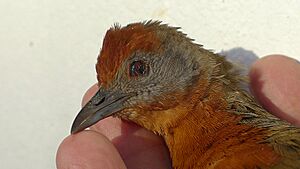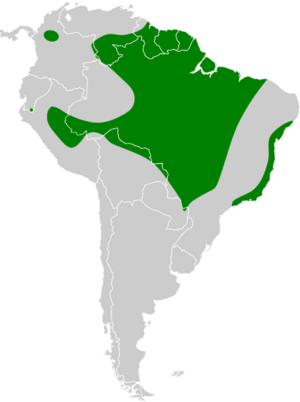Russet-crowned crake facts for kids
Quick facts for kids Russet-crowned crake |
|
|---|---|
 |
|
| Conservation status | |
| Scientific classification | |
| Genus: |
Rufirallus
|
| Species: |
viridis
|
 |
|
| Synonyms | |
|
|
The russet-crowned crake (Rufirallus viridis) is a small, shy bird. It belongs to the Rallidae family, which includes rails, gallinules, and coots. You can find this bird in many South American countries. These include Bolivia, Brazil, Colombia, Ecuador, the Guianas, Paraguay, Peru, and Venezuela.
Contents
About the Crake's Family Tree
Scientists sometimes disagree on the exact family name for the russet-crowned crake. Some groups, like the International Ornithological Committee (IOC), place it in the Rufirallus group. They put it with the chestnut-headed crake. Other groups, like the American Ornithological Society, place it in the Anurolimnas group. This group also includes the chestnut-headed crake and the black-banded crake.
Even with these small differences, everyone agrees on one thing. The russet-crowned crake has two main types, called subspecies. They are R. v. viridis and R. v. brunnescens.
What Does This Bird Look Like?
The russet-crowned crake is about 16 to 18 centimeters (6 to 7 inches) long. That's about the length of a common pencil! Males weigh around 55 to 63 grams (1.9 to 2.2 ounces). Females are a bit heavier, weighing 69 to 73 grams (2.4 to 2.6 ounces). Both male and female crakes look very similar.
Adult crakes have a black beak and red legs. Their face is gray, and they have a reddish-brown top of the head, called a russet crown. The most common type, R. v. viridis, has brownish-olive feathers on its back. Its belly feathers are a reddish-brown color. Young crakes are light brown with a black face and dull pink legs. The other type, R. v. brunnescens, is a little bigger. It has browner feathers on its back and lighter colors on its head and belly.
Where Does the Crake Live?
The R. v. viridis subspecies lives in a wide area. You can find it from eastern Colombia and southern Venezuela. Its range goes east through the Guianas and into Brazil. It also spreads south and west into eastern Peru, northern and eastern Bolivia, and eastern Paraguay. There are also separate groups of this crake. One lives in Ecuador's Zamora-Chinchipe Province. Another lives in southeastern Brazil, between the states of Alagoas and São Paulo.
The R. v. brunnescens subspecies lives in north-central Colombia. It can be found from the lower Cauca River valley east into the middle Magdalena River valley.
Unlike many other birds in its family, the russet-crowned crake usually lives on land. It prefers areas that are not wet marshes. You can often find it in thickets of young trees. It also likes grassy fields, overgrown areas, and gardens near small towns. These birds live from sea level up to about 1,200 meters (3,900 feet) high.
How Does the Crake Behave?
What Does the Crake Eat?
We don't know much about what the russet-crowned crake eats or how it finds food. It usually looks for food hidden in plants. We do know that its diet includes insects and grass seeds.
How Does the Crake Reproduce?
The russet-crowned crake's breeding season is from January to June. It builds a round nest from dead grass. The nest has an opening on the side. It is usually hidden about 1 meter (3 feet) high in a bush or other thick plants. A female crake lays one to three eggs. Beyond this, not much else is known about how they raise their young.
What Sounds Does the Crake Make?
The russet-crowned crake calls most often in the early morning and evening. Its call sounds like a "dry rattling." People have compared it to the sound of a seashell wind chime.
Is the Russet-crowned Crake Safe?
The IUCN (International Union for Conservation of Nature) has looked at the russet-crowned crake. They have listed it as a species of "Least Concern." This means it is not currently in danger of disappearing. It lives across a very large area. However, we don't know how many of these birds there are or if their numbers are changing. No immediate threats to the species have been found. The R. v. viridis subspecies is thought to be common in most of its range. The status of R. v. brunnescens is not yet known.


